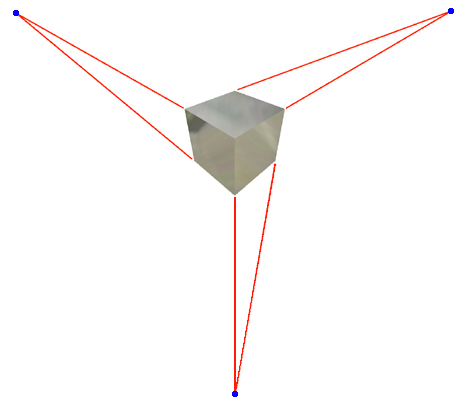
In Perspective Camera mode, part or assembly models are displayed in three-point perspective, a visual effect in which parallel lines converge on a vanishing point. This effect is the way real objects are perceived by the human eye or by a camera.
By default, the Zoom command works in conjunction with a fixed target point. You can use the Zoom command with keyboard key combinations to move the camera and the camera target point simultaneously. These key combinations used with the Pan command allow you to navigate the model in 3D.
Some of the View commands behave differently when you select Perspective Camera mode.
Zoom Window
|
|
Because zoom values are dependent on your distance from the model in Perspective Camera mode, it is necessary to specify a target point on the model. The zoom window has a cross hair in the center of the rectangle to pick the target point. |
Zoom
|
|
Perspective Camera mode uses two types of zoom: camera position and lens focal length. |
Camera position zoom has the effect of changing your position, either further from or closer to the camera target point. As zoom values change, the relative sizes of edge lengths and surface areas change. Edges and surfaces closer to you appear larger. Edges and surfaces further from you appear smaller, relative to those edges and surfaces which are closer. When zooming in, edges and surfaces that are further from you can also become increasingly obfuscated by the edges and surfaces that are closer.
Lens focal length zoom is the same as zooming the lens on a camera or camcorder. As zoom values change, the relative sizes of various edge lengths and surface areas do not change. Lengths and surfaces become equally larger or equally smaller.
The default zoom type is camera position.
Pan
|
|
Perspective Camera mode uses two types of pan: camera translation and camera pivot. |
Camera translation pan has the effect of moving you parallel to the screen without changing the direction of your line of sight. While you pan, your line of sight does not remain trained upon a fixed point. Camera translation pan changes the aspect of various edges and surfaces as they correspond to your line of sight.
Camera pivot pan has the effect of sweeping your line of sight across the model as your line of sight starts from a fixed point. It is as if you are pivoting your head from side to side. The relative sizes of various edges and surfaces remain unchanged.
The default pan type is camera translation.